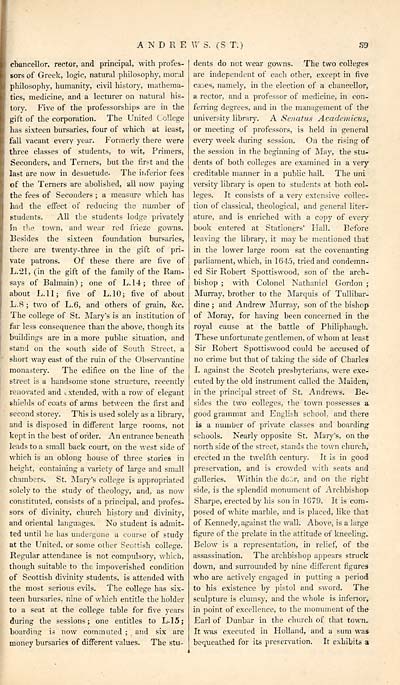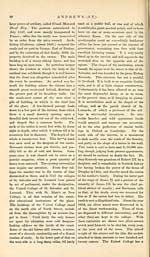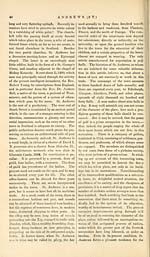Gazetteer of Scotland > Volume 1
(67) Page 39 - AND
Download files
Complete book:
Individual page:
Thumbnail gallery: Grid view | List view

ANDR E W S. (S T.)
S9
chancellor, rector, and principal, with profes-
sors of Greek, logic, natural philosophy, moral
philosophy, humanity, civil history, mathema-
tics, medicine, and a lecturer on natural his-
tory. Five of the professorships are in the
gift of the corporation. The United College
has sixteen bursaries, four of winch at least,
fall vacant every year. Formerly there were
three classes of students, to wit, Primers,
Seconders, and Terners, but the first and the
last are now in desuetude. The inferior fees
of the Terners are abolished, all now paying
the fees of Seconders ; a measure which has
had the effect of reducing the number of
students. All the students lodge privately
$n the town, and wear red frieze gowns.
Besides the sixteen foundation bursaries,
there are twenty-three in the gift of pri-
vate patrons. Of these there are five of
L.21, (in the gift of the family of the Ram-
says of Balmain) ; one of L.14; three of
about L.llj five of L.10; five of about
L.8 ; two of L.6, and others of grain, &c.
The college of St. Mary's is an institution of
far less consequence than the above, though its
buildings are in a more public situation, and
stand on the south side of South Street, a
short way east, of the ruin of the Observantine
monastery. The edifice on the line of the
street is a handsome stone structure, recently
renovated and extended, with a row of elegant
shields of coats of arms between the first and
second storey. This is used solely as a library,
and is disposed in different large rooms, not
kept in the best of order. An entrance beneath
leads to a small back court, on the west side of
which is an oblong house of three stories in
height, containing a variety of large and small
chambers. St. Mary's college is appropriated
solely to the study of theology, and, as now
constituted, consists of a principal, and profes-
sors of divinity, church history and divinity,
and oriental languages. No student is admit-
ted until he lias undergone a course of study
at the United, or some other Scottish college.
Regular attendance is not compulsory, which,
though suitable to the impoverished condition
of Scottish divinity students, is attended with
the most serious evils. The college has six-
teen bursaries, nine of M'hich entitle the holder
to a seat at the college table for five years
during the sessions; one entitles to L.15;
boarding is now commuted ; and six are
money bursaries of different values. The stu-
dents do net wear gowns. The two colleges
are independent of each other, except in five
cases, namely, in the election of a chancellor,
a rector, and a professor of medicine, in con-
ferring degrees, and in the management of the
university library. A Senatus Academicus,
or meeting of professors, is held in general
every week during session. On the rising of
the session in the beginning of Maj', the stu-
dents of both colleges are examined in a very
creditable manner in a public hall. The uni
versity library is open to students at both col-
leges. It consists of a very extensive collec-
tion of classical, theological, and general liter-
ature, and is enriched with a copy of every
book entered at Stationers' Kail. Before
leaving the library, it may be mentioned that
in the lower large room sat the covenanting
parliament, which, in 164.5, tried and condemn-
ed Sir Robert Spottiswood, son of the arch-
bishop ; with Colonel Nathaniel Gordon ;
Murray, brother to the Marquis of Tullibar-
dine ; and Andrew Murray, son of the bishop
of Moray, for having been concerned in the
royal cause at the battle of Philiphaugh.
These unfortunate gentlemen, of whom at least
Sir Robert Spottiswood could be accused of
no crime but that of taking the side of Charles
I. against the Scotch presbyterians, were exe-
cuted by the old instrument called the Maiden,
in the principal street of St. .Andrews. Be-
sides the two colleges, the town possesses a
good grammar and English school, and there
is a number of private classes and boarding
schools. Nearly opposite St. Mary's, on the
north side of the street, stands the town church,
erected m the twelfth century. It is in good
preservation, and is crowded with seats and
galleries. Within the do^r, and on the right
side, is the splendid monument of Archbishop
Sharpe, erected by his son in 1679. It is com-
posed of white marble, and is placed, like that
of Kennedy, against the wall. Above, is a large
figure of the prelate in the attitude of kneeling.
Below is a representation, in relief, of the
assassination. The archbishop appears struck
down, and surrounded by nine different figures
who are actively engaged in putting a period
to his existence by pistol and sword. The-
sculpture is clumsy, and the whole is inferior,
in point of excellence, to the monument of the
Earl of Dunbar in the church of that town.
It was executed in Holland, and a sum was
bequeathed for its preservation. It exhibits a
S9
chancellor, rector, and principal, with profes-
sors of Greek, logic, natural philosophy, moral
philosophy, humanity, civil history, mathema-
tics, medicine, and a lecturer on natural his-
tory. Five of the professorships are in the
gift of the corporation. The United College
has sixteen bursaries, four of winch at least,
fall vacant every year. Formerly there were
three classes of students, to wit, Primers,
Seconders, and Terners, but the first and the
last are now in desuetude. The inferior fees
of the Terners are abolished, all now paying
the fees of Seconders ; a measure which has
had the effect of reducing the number of
students. All the students lodge privately
$n the town, and wear red frieze gowns.
Besides the sixteen foundation bursaries,
there are twenty-three in the gift of pri-
vate patrons. Of these there are five of
L.21, (in the gift of the family of the Ram-
says of Balmain) ; one of L.14; three of
about L.llj five of L.10; five of about
L.8 ; two of L.6, and others of grain, &c.
The college of St. Mary's is an institution of
far less consequence than the above, though its
buildings are in a more public situation, and
stand on the south side of South Street, a
short way east, of the ruin of the Observantine
monastery. The edifice on the line of the
street is a handsome stone structure, recently
renovated and extended, with a row of elegant
shields of coats of arms between the first and
second storey. This is used solely as a library,
and is disposed in different large rooms, not
kept in the best of order. An entrance beneath
leads to a small back court, on the west side of
which is an oblong house of three stories in
height, containing a variety of large and small
chambers. St. Mary's college is appropriated
solely to the study of theology, and, as now
constituted, consists of a principal, and profes-
sors of divinity, church history and divinity,
and oriental languages. No student is admit-
ted until he lias undergone a course of study
at the United, or some other Scottish college.
Regular attendance is not compulsory, which,
though suitable to the impoverished condition
of Scottish divinity students, is attended with
the most serious evils. The college has six-
teen bursaries, nine of M'hich entitle the holder
to a seat at the college table for five years
during the sessions; one entitles to L.15;
boarding is now commuted ; and six are
money bursaries of different values. The stu-
dents do net wear gowns. The two colleges
are independent of each other, except in five
cases, namely, in the election of a chancellor,
a rector, and a professor of medicine, in con-
ferring degrees, and in the management of the
university library. A Senatus Academicus,
or meeting of professors, is held in general
every week during session. On the rising of
the session in the beginning of Maj', the stu-
dents of both colleges are examined in a very
creditable manner in a public hall. The uni
versity library is open to students at both col-
leges. It consists of a very extensive collec-
tion of classical, theological, and general liter-
ature, and is enriched with a copy of every
book entered at Stationers' Kail. Before
leaving the library, it may be mentioned that
in the lower large room sat the covenanting
parliament, which, in 164.5, tried and condemn-
ed Sir Robert Spottiswood, son of the arch-
bishop ; with Colonel Nathaniel Gordon ;
Murray, brother to the Marquis of Tullibar-
dine ; and Andrew Murray, son of the bishop
of Moray, for having been concerned in the
royal cause at the battle of Philiphaugh.
These unfortunate gentlemen, of whom at least
Sir Robert Spottiswood could be accused of
no crime but that of taking the side of Charles
I. against the Scotch presbyterians, were exe-
cuted by the old instrument called the Maiden,
in the principal street of St. .Andrews. Be-
sides the two colleges, the town possesses a
good grammar and English school, and there
is a number of private classes and boarding
schools. Nearly opposite St. Mary's, on the
north side of the street, stands the town church,
erected m the twelfth century. It is in good
preservation, and is crowded with seats and
galleries. Within the do^r, and on the right
side, is the splendid monument of Archbishop
Sharpe, erected by his son in 1679. It is com-
posed of white marble, and is placed, like that
of Kennedy, against the wall. Above, is a large
figure of the prelate in the attitude of kneeling.
Below is a representation, in relief, of the
assassination. The archbishop appears struck
down, and surrounded by nine different figures
who are actively engaged in putting a period
to his existence by pistol and sword. The-
sculpture is clumsy, and the whole is inferior,
in point of excellence, to the monument of the
Earl of Dunbar in the church of that town.
It was executed in Holland, and a sum was
bequeathed for its preservation. It exhibits a
Set display mode to: Large image | Transcription
Images and transcriptions on this page, including medium image downloads, may be used under the Creative Commons Attribution 4.0 International Licence unless otherwise stated. ![]()
| Gazetteers of Scotland, 1803-1901 > Gazetteer of Scotland > Volume 1 > (67) Page 39 - AND |
|---|
| Permanent URL | https://digital.nls.uk/97425166 |
|---|
| Description | Volume I: Abbey to Glenartney. |
|---|---|
| Attribution and copyright: |
|
| Description | By Robert Chambers and William Chambers. Glasgow: Blackie & Son, 1838. 2 volumes. |
|---|---|
| Shelfmark | NF.1461.g.7 |
| Additional NLS resources: | |

